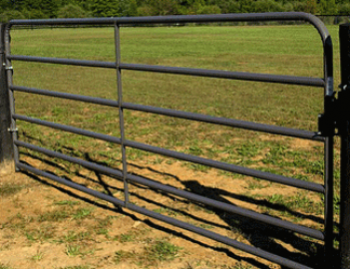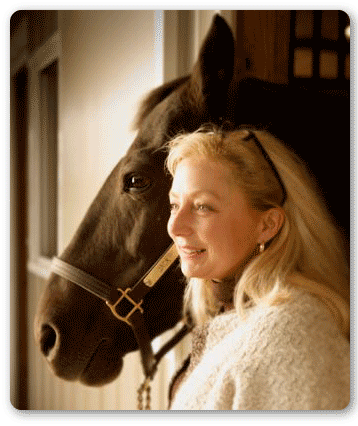Hold Your Horses

When my horses escaped my immediate fear was injury occurring to them or even to a person – especially with our busy road, children out playing, or good samaritans stepping in to lend a hand. Fortunately, my horses are obsessed with their grain! So with a shake of the bucket and a little creative waving, I had them safely back in their pasture with the gate closed. It can happen to even the most-conscientious horse owner. We get used to the routine, and double-check everything before heading to the house. But once in a while, distractions and busy schedules intervene.
Most horse fencing gates are placed at high-traffic areas.
Horses learn very quickly the access route to the barn where they are groomed, get attention and best of all, eat. The repetitive positive reinforcement they receive every time they pass through the gate is the reason horses push and shove or stand and paw the gate area.
With horses that pack around 1,200 pounds or more, it doesn't take much for them to push open, or even break through a gate.
The only solution is to ensure you have a good quality gate with the best latch you can find. It may be a worn cliche, but when it comes to gates and gate hardware, you truly do get what you pay for. A gate constructed of 2-inch heavy-gauge, tubular steel that does not have sharp-edged slats inserted for reinforcement that can cause injury to your horse is a great option. Our draft horse "Fred" has shoes in front and is relentless about pawing our gate at feeding time. Our 2-inch tubular steel gate has held up, without dents, for years.
When planning your horse fence gates, think about both current and future uses for any gate area.
It is always easier to plan a gate area at the time of fence installation, as opposed to adding one later. The best gate size depends on the intended use of the gate. Four-foot gates are rarely used with full size horses and will really limit the size of equipment you can maneuver through the opening. If a gate area is going to allow mounted riders to pass through, a four-foot opening does not allow much room for the width of the horse plus the legs and knees of the rider.
Eight to 12-foot horse fencing gates work well for turnout or catch areas.
When in doubt, go with a 16-foot gate. This utility size gate will accommodate most tractors, spreaders, trucks and trailers. For larger equipment, consider installing a double gate.
Remember that the longer the gate, the heaver it will be.
Gateposts will need to be set in concrete and braced to prevent leaning and dragging. Use gate wheels on longer gates to help support the gate, keep it from sagging, and make it easier to control. On double gates, install a drop pin so that you can open one side without the other swinging wide.
A good horse fencing gate is really only as good as its latching mechanism.
I think some of the most creative works of art I have seen are homemade gate latches. Ropes, chains, bungee cords, wood latches, baling twine, you name it, and I have probably seen it.
A heavy-duty gate latch can make a big difference in the security a gate provides.
One-way latches provide extra strength when the latch is installed on the inside, facing the pasture. When your horse pushes against it, the latch can't give and the horse is pushing against the post, too.
Two-way latches allow horse fencing gates to swing both ways, which can be very convenient during the spring and fall.
When your horses congregate in the gate area and it becomes muddy, the gate can swing outward avoiding any mud or frozen dirt that can literally stop a gate from opening.
Locking two-way latches will make horse fence gates more secure.
If you have a gate located near a road or public access area, or if you have reason to be concerned about foul play, locking latches offer a good preventative measure for peace of mind.
A chain with a quick-release latch, which can be operated easily with one hand, works well in frequently accessed areas, areas close to the barn, riding arenas, or at inner barn gates.
It is a simple, yet effective latch that is stronger and more secure than a jerry-rigged version.
If you have a boarding facility, work with youth riders, or give lessons, good gates and latches are essential. Choose gates and latches that are easy to use and work well. You may consider using two latches in pastures with many horses: one heavy-duty latch and one quick release latch. You'll improve your chances that at least one of the two will get used. So hold your horses, and hold them well. If you want to go out for a jog, let it be on your schedule, not when your horse decides the grass is greener on the other side.
 Debbie has over 45 years experience with horses and equine-related businesses. She has owned, trained, boarded horses and run stables at various times in her career. She is a certified fence installer, has given balanced riding lessons, and has shown horses in Western, Western Pleasure, Trail, English, Hunter/Jumper, Fox Hunting, Hunter Trials, Dressage and driving classes. Debbie has been involved in foaling, and just about every aspect of horse ownership possible, and she welcomes your questions and comments. If you are interested in using any articles by Debbie, please send her an email.
Debbie has over 45 years experience with horses and equine-related businesses. She has owned, trained, boarded horses and run stables at various times in her career. She is a certified fence installer, has given balanced riding lessons, and has shown horses in Western, Western Pleasure, Trail, English, Hunter/Jumper, Fox Hunting, Hunter Trials, Dressage and driving classes. Debbie has been involved in foaling, and just about every aspect of horse ownership possible, and she welcomes your questions and comments. If you are interested in using any articles by Debbie, please send her an email.
RAMM Fence Systems, Inc. makes every effort to provide reliable and useful information on horse health, care and products. The statements made on this website are based on years of experience with horses, however, they are based on generalized situations and should not replace diagnosis or treatment by a veterinarian or consultation by a professional. RAMM Fence Systems, Inc. does not assume any legal responsibility. Readers should always consult qualified health care providers for specific diagnosis and treatment.
